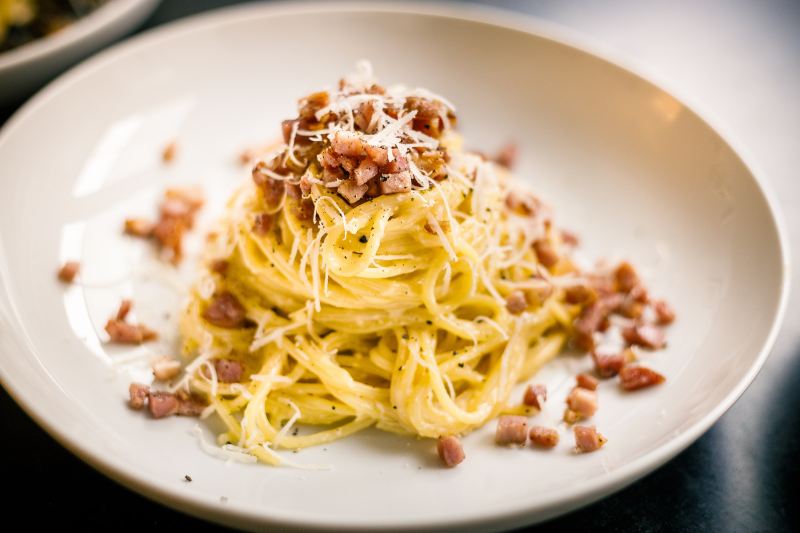
Pasta carbonara is one of those unique foods that are somehow simultaneously simple yet complex, perfect for either a drunken meal at 2 a.m. or for a sophisticated dinner to impress the in-laws. It’s truly just perfect for any occasion – rich and comforting, classic and elegant. As with most beautifully simple dishes, though, there’s the added pressure of getting every single bit just right. With so few ingredients, each one must shine, and with such a modest sauce, the texture must be flawless. And in carbonara, that can be a tricky thing to do.
Carbonara sauce is made mainly of egg yolks which can easily curdle when combined with hot pasta. And while everyone loves scrambled eggs, they don’t belong in this dish. In fact, it’s the entirely opposite texture one wants to achieve in carbonara. The sauce should be silky and velvety smooth, with no hint of a lumpy or grainy texture. And with a few simple tricks, this perfect sauce is very easy to achieve.

Pasta carbonara recipe
Ingredients:
- 2 tablespoons bacon fat (or olive oil)
- 1/2 pound pancetta, diced
- 1 tablespoon olive oil
- 2 egg yolks, room temperature
- 2 whole eggs, room temperature
- 1 cup Pecorino Romano cheese, finely shredded (plus more for serving)
- 1 pound bucatini
- 1 teaspoon freshly ground black pepper
- Kosher salt to taste
Method:
- Cook bucatini in salted water, according to package directions, until al dente.
- Combine bacon fat and pancetta in a large skillet and cook over medium heat until fat has rendered and pancetta is crisp.
- In a large, metal, heatproof bowl, whisk together whole eggs and yolks, cheese, and black pepper, and set aside.
- Remove pasta from water using tongs, leaving the boiling water on the stove.
- From the pot, remove about one cup of pasta water and set aside.
- Add pasta to the pancetta pan and toss with olive oil to combine.
- Slowly and carefully pour the contents of the pasta and pancetta pan into the egg mixture, making sure to get all of the rendered fat from the pan.
- A little bit at a time, drizzle in about 1/2 cup of reserved pasta water, mixing constantly with tongs.
- Place the metal bowl containing the pasta mixture on top of the pasta water pot, creating a double boiler. Be sure that the bottom of the bowl is not touching the water.
- Continue to cook pasta in the sauce for an additional 2-3 minutes, until sauce has thickened slightly and become silky.
- Remove from heat and serve immediately.

Pasta carbonara tips and tricks
- Spaghetti carbonara is traditional, but we absolutely love using bucatini instead. The hollow center inside captures the sauce in a way spaghetti doesn’t, making the dish even richer and more luxurious.
- When it comes to the pork in this dish, guanciale (pork jowl) is the most traditional choice, and if you can find it, great! However, this ingredient can be a bit tricky to track down. Pancetta makes for a beautiful substitute. Bacon is also delicious (obviously) but less traditional than guanciale or pancetta.
- Cold eggs can lead to a lumpy sauce, so be sure to bring your eggs to room temperature before using.
- This double boiler method is the best method we’ve tried when it comes to avoiding scrambled eggs in this sauce. It isn’t necessary, but it is the best way to get around a possible curdling catastrophe.
- Of course, you should always be grating your own cheese instead of buying the pre-shredded stuff. In this recipe, it’s important to grate the cheese as finely as possible for even and quick melting in the sauce.
- Pasta water is the key to making this sauce (and most pasta sauces) silky. Add just a little bit at a time until you reach your desired consistency.
Editors' Recommendations
- This eggnog French toast recipe may be your new holiday breakfast favorite (it’s definitely ours)
- Our bone broth recipe is embarrassingly easy and better than store-bought
- A chef gives us the secret key ingredient to make perfect fried chicken (and the one step most people get wrong!)
- Our mashed potato recipe is the only one you’ll ever need (and it’s easy to memorize, too!)
- We love these Keto diet Thanksgiving recipes from a professional chef




